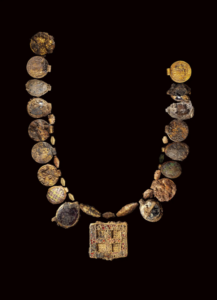1,300-Year-Old Gold Necklace May Have Belonged to a Woman Who Was An Early Christian Leader
A 1,300-year-old gold-and-gemstone necklace that was recently discovered in an ancient grave site in England may have belonged to a woman who was an early Christian leader, according to experts involved in the discovery.
The ancient jewelry was unearthed in Northamptonshire in April during excavations that took place ahead of a planned housing development, according to RPS, a professional services firm that managed the archaeological investigation on behalf of the housing developer, Vistry Group.
The 30 pendants and beads that once formed the elaborate necklace were made from Roman coins, gold, garnets, glass and semiprecious stones. The centerpiece of the necklace, a rectangular pendant with a cross motif, was also among the artifacts that were discovered.
“When the first glints of gold started to emerge from the soil we knew this was something significant,” Levente-Bence Balázs, a site supervisor at the Museum of London Archaeology, who led a team of five that made the discovery, said on Wednesday in a statement announcing the find. “However, we didn’t quite realize how special this was going to be.”
X-rays of soil blocks lifted from the grave also revealed an elaborately decorated cross featuring unusual depictions of human faces cast in silver, the statement said.
While the soil is being investigated more closely, “this large and ornate piece suggests the woman may have been an early Christian leader,” the statement said, adding that she might have been an abbess, royalty or both. The site also contained two decorated pots and a shallow copper dish.
The skeleton itself has decomposed, with only tiny fragments of tooth enamel remaining. But the Museum of London Archaeology said it was almost certain that a woman was buried there because similar necklaces and lavish burial sites were almost exclusively found in female graves in the period.
Scholars said the discovery pointed to the important but often overlooked role of women in the development of early Christianity.
